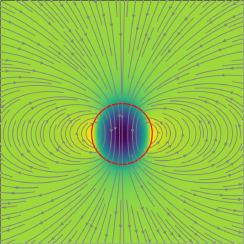Implementation of integral surface tension formulations in a volume of fluid framework and their applications to Marangoni flows
IF 3.8
2区 物理与天体物理
Q2 COMPUTER SCIENCE, INTERDISCIPLINARY APPLICATIONS
引用次数: 0
Abstract
Accurate numerical modeling of surface tension has been a challenging aspect of multiphase flow simulations. The integral formulation for modeling surface tension forces is known to be consistent and conservative, and to be a natural choice for the simulation of flows driven by surface tension gradients along the interface. This formulation was introduced by Popinet and Zaleski [1] for a front-tracking method and was later extended to level set methods by Al-Saud et al. [2]. In this work, we extend the integral formulation to a volume of fluid (VOF) method for capturing the interface. In fact, we propose three different schemes distinguished by the way we calculate the geometric properties of the interface, namely curvature, tangent vector and surface fraction from VOF representation. We propose a coupled level set volume of fluid (CLSVOF) method in which we use a signed distance function coupled with VOF, a height function (HF) method in which we use the height functions calculated from VOF, and a height function to distance (HF2D) method in which we use a sign-distance function calculated from height functions. For validation, these methods are rigorously tested for several problems with constant as well as varying surface tension. It is found that from an accuracy standpoint, CLSVOF has the least numerical oscillations followed by HF2D and then HF. However, from a computational speed point of view, HF method is the fastest followed by HF2D and then CLSVOF. Therefore, the HF2D method is a good compromise between speed and accuracy for obtaining faster and correct results.

流体框架体积中整体表面张力公式的实现及其在马兰戈尼流中的应用
表面张力的精确数值模拟一直是多相流模拟的一个具有挑战性的方面。众所周知,模拟表面张力的积分公式是一致和保守的,并且是模拟沿界面表面张力梯度驱动的流动的自然选择。该公式由Popinet和Zaleski等人([1])引入到一种前沿跟踪方法中,后来由al - saud等人([1])扩展到水平集方法中。在这项工作中,我们将积分公式推广到流体体积(VOF)方法来捕获界面。事实上,我们提出了三种不同的方案,根据我们计算界面几何性质的方式来区分,即曲率、切矢量和VOF表示的表面分数。我们提出了一种耦合水平集流体体积(CLSVOF)方法,其中我们使用一个带符号的距离函数与VOF耦合,一个高度函数(HF)方法,我们使用从VOF计算的高度函数,以及一个高度函数到距离(HF2D)方法,我们使用一个从高度函数计算的符号距离函数。为了验证,这些方法在几个具有恒定和变化表面张力的问题上进行了严格的测试。从精度角度看,CLSVOF的数值振荡最小,其次是HF2D,最后是HF。但从计算速度来看,HF方法最快,其次是HF2D,最后是CLSVOF。因此,HF2D方法在速度和精度之间取得了很好的折衷,可以获得更快、更准确的结果。
本文章由计算机程序翻译,如有差异,请以英文原文为准。
求助全文
约1分钟内获得全文
求助全文
来源期刊

Journal of Computational Physics
物理-计算机:跨学科应用
CiteScore
7.60
自引率
14.60%
发文量
763
审稿时长
5.8 months
期刊介绍:
Journal of Computational Physics thoroughly treats the computational aspects of physical problems, presenting techniques for the numerical solution of mathematical equations arising in all areas of physics. The journal seeks to emphasize methods that cross disciplinary boundaries.
The Journal of Computational Physics also publishes short notes of 4 pages or less (including figures, tables, and references but excluding title pages). Letters to the Editor commenting on articles already published in this Journal will also be considered. Neither notes nor letters should have an abstract.
 求助内容:
求助内容: 应助结果提醒方式:
应助结果提醒方式:


